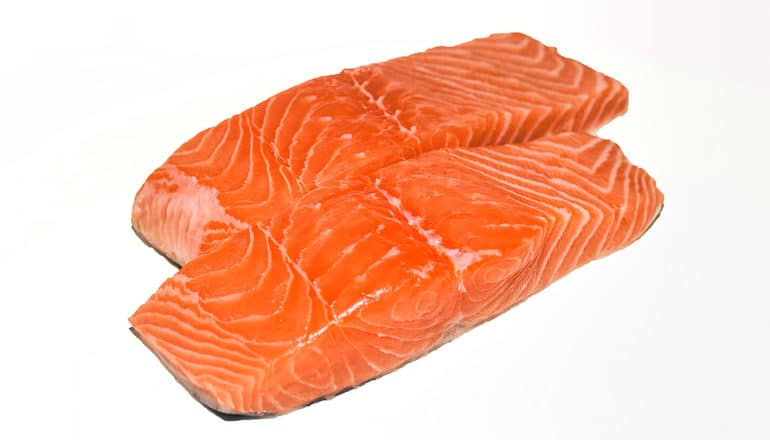
A blind taste test demonstrates that Danes prefer the taste of both conventionally and organically farmed smoked salmon over wild-caught salmon.
However, the picture is turned upside down the second people find out where a fish comes from.
A great many packages of sliced and vacuum-sealed smoked salmon find their way into Danish shopping carts every year. The vast majority of this smoked salmon is sourced from Norwegian aquaculture farms.
In recent times however, conventionally farmed salmon from Norway has earned a questionable reputation and notoriety for containing pharmaceutical and chemical residues, as well as for polluting the marine environment and spreading disease to wild populations.
However, according to the Danish Veterinary and Food Administration salmon on the Danish market does not have a problem with unwanted chemicals, and it is very rare that the authorities find pharmaceutical residues.
But it seems that our knowledge about production conditions plays a major role in how we perceive taste. A study by University of Copenhagen researchers drives the point home.
In the study, 92 Danes were asked to taste samples of conventional, organic, and wild-caught smoked salmon. The first round was a blind test in which test subjects were uninformed about what type of salmon they were tasting. In the second round, the subjects were informed. Following each round, the test subjects assessed their liking of the samples.
3 types of smoked salmon
- Conventionally farmed salmon: Most conventional aquaculture takes place in farms where fish live in netted pens. There is an environmental impact in terms of the discharge of chemical and pharmaceutical residues, just as the farmed salmon itself may in very rare cases contain residues of medications used to combat salmon lice.
- Organically farmed salmon: Fish live in netted pens, but with more space. The use of medications is minimal and no genetically modified feed is used.
- Wild salmon: Many Atlantic salmon stocks are overfished or fully exploited, while several stocks in the North Pacific are robust. Wild salmon have a higher content of environmental poisons than farmed salmon (though not at an alarming level). On the other hand, wild salmon generally have a higher content of omega-3 fatty acids.
Expectations shape taste
In the blind test, the conventional and organic salmons won big over wild salmon, which scored significantly lower than either of the two farmed products. Beyond that, the conventional salmon tended to be liked more than the organic. However, once the test subjects were informed about the production method, things quickly turned upside down. Among informed respondents, the conventional salmon placed last, while the wild salmon took second, and the organic, first.
“The test demonstrates that people’s expectations about a product are based on information they receive, and that this affects their overall taste experience. With smoked salmon, there seems to be a perception that wild-caught salmon ought to taste better than salmon which is conventionally farmed. However, the blind test revealed that people simply preferred the taste of farmed salmon,” says first author and PhD fellow Mausam Budhathoki, who conducted the study in conjunction with his graduate thesis at the food science department.
According to the researchers, there are several possible explanations for people’s preference for farmed fish.
“One possibility is that people are most familiar with both the taste and color of farmed salmon, as this is clearly the most widely available type of salmon on the market. Another reason may be that wild salmon has less flavor due to it being leaner than farmed salmon, as was the case here,” suggests Budhathoki.
Knowledge gaps
The study, which included focus group interviews as well, reveals that Danes don’t know much about farm-raised salmon.
“It seems that many Danes are quite confused about the differences between various salmon products. This is with good reason, as the salmon production chain is long and relatively opaque. Many factors can influence perceptions about a product. Is there any pharmaceutical residue in it? Does it come from an overfished stock? Has it lived a natural life? And what exactly is fish welfare?” says senior author Helene Christine Reinbach, an associate professor at the food science department.
“In the test, wild salmon clearly wins points with regards to information about its provenance,” she says. “It provides positive associations about being more natural, and consequently, better in terms of animal welfare and health. The fact is, however, that only farmed salmon is eligible for organic certification in Denmark, where there are strict requirements for sustainability, health, and animal welfare in production. On the other hand, most wild salmon stocks in our part of the world are in bad shape and have higher concentrations of environmental toxins than farmed salmon.”
Organic salmon
Despite their higher price, many organic foods have significantly increased their market shares in Denmark in recent years. Nevertheless, sales of organic fish—including salmon—remain sluggish. As the organic salmon scored highly in both rounds of the taste test, the researchers believe that there is obvious potential for organic smoked salmon producers and other stakeholders.
“There is a clear opportunity for promotion, in equipping consumers with more information about the positives that differentiate organic salmon from both conventional and wild-caught salmon. For example, more information could be included on packaging to help guide consumers, in relation to the sustainability and health benefits of organic smoked salmon. At the same time, the sector should work to increase the availability of organic choices in local shops, as it can still be tough to get a hold of,” says Reinbach.
The study appears in Food Quality and Preference.
Source: University of Copenhagen
The post Expectations shape salmon taste test appeared first on Futurity.